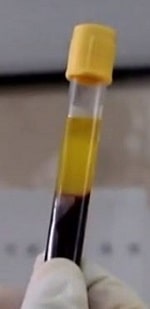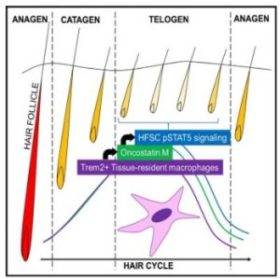I have mentioned platelet-rich plasma (PRP) in a dozen or so posts on this blog over the past three years. The positive effect of PRP on hair growth is somewhat controversial. However, there is no controversy when it comes to the fact that PRP contains numerous concentrated growth factors (GFs). And many of these growth factors are known to at least modestly benefit hair thickness as well as hair quantity.

In the past I have briefly discussed some of the key growth factors that are highly concentrated in PRP. I think it is worth having a separate post here that discusses all of them in a bit more detail. There is a good chance that I am still missing things, so any corrections and suggestions are welcome via the comments.
It should be noted that even many non-PRP related hair loss products target one or more of the below listed growth factors in order to stimulate hair growth. There is a good chance that both PRP as well as hair loss products that contain some of the below growth factors make existing hair stronger. However, it is unlikely that such products ever bring back hair that has been lost for a long time.
Growth Factors in Platelet-Rich Plasma
The key growth factors in PRP treatment that are supposedly beneficial to hair growth are:
- Insulin-Like Growth Factor 1 (IGF-1).
- Fibroblast Growth Factor (FGF).
- Platelet-Derived Growth Factor (PDGF).
- Vascular Endothelial Growth Factor (VEGF).
- Epidermal Growth Factor (EGF).
- Transforming Growth Factor Beta (TGF-β).
- Nerve Growth Factor (NGF).
IGF-1
I start with the growth hormone insulin-like growth factor 1 (IGF-1) because I have already covered it a few times before.
- Promotion of IGF-1 expression is one of the main considerations behind Shiseido’s bestselling adenosine based products.
- US-based Follicept was targeting IGF-1 delivery in its hair loss product, prior to the company’s demise.
- Adipose-derived stem cells (ADSCs — an exciting recent development in the hair loss world) are rich in various growth factors, including IGF-1.
- Last year, an important and widely publicized study found that topical application of oleuropein (derived from the leaves of olive drupes) induces hair growth in mice. According to the study findings, oleuropein-treated mouse skin showed substantial upregulation of IGF-1.
FGF
I list fibroblast growth factor (FGF) next because I have also covered it many times on this blog before. There are 22 types of FGFs numbered FGF-1 through FGF-22. A significant number of these influence hair growth. I may write an entire detailed post on FGFs at some point in the future. I have covered some of the key ones on this blog before, in particular FGF-5, which discourages hair growth and has to be inhibited. Australian company Cellmid’s Evolis line of products claims to inhibit FGF-5.
Note that PRP does not inhibit growth factors. So it is more relevant for the purposes of this post to discuss some of the FGFs that promote hair growth. It seems like the main ones are FGF-1, FGF-2, FGF-7, FGF-9 and FGF-10. Evidence for three of those (FGF-1, FGF-2 and FGF-10) and their positive effects on hair is found in an important 2014 study from China. Fibroblast growth factors stimulate hair growth through β-Catenin and Shh expression.
Note that “hair cell regeneration” or variations of that term are mentioned a number of times in this study, even if in mice. PRP is said to increase FGF-2 concentration levels. Interestingly, when I interviewed Dr. Malcolm Xing last year, he mentioned that FGF-2 is the preferred growth factor used at this clinic for his work purposes.
FGF-9 has become an especially important growth factor in large part due to the work of the renowned Dr. George Cotsarelis, who holds a patent titled “Fibroblast growth factor-9 promotes hair follicle regeneration after wounding“. Dr. Cotsarelis is also a co-author of a 2013 paper that concludes: “The importance of FGF-9 in hair follicle regeneration suggests that it could be used therapeutically in humans“.
Finally, FGF-7 (also called keratinocyte growth factor, or KGF) is required for hair growth. The well known researcher Dr. Elaine Fuchs co-authored an important study on FGF-7, hair development and wound healing all the way back in 1995. Moreover, Histogen’s Hair Stimulating Complex product is focusing on KGF as one of the key growth factors to be injected in human scalps.
PDGF
Platelet-derived growth factor (PDGF) is a key growth factor involved in blood vessel formation. A 2006 study from Japan found that “PDGF isoforms induce and maintain anagen phase of murine hair follicles“. Adipose-derived stem cells (ADSCs) are rich in various growth factors, including PDGF, and are increasingly utilized in the hair loss world.
VEGF
Besides hair growth, vascular endothelial growth factor (VEGF) is also involved in blood vessel formation. A 2001 study concluded that “normal hair growth and size are dependent on VEGF-induced perifollicular angiogenesis”. Note that Shiseido’s adenosine based shampoo also promotes the expression of VEGF. The previously discussed adipose-derived stem cells are also rich in various growth factors including VEGF.
Also, one of the ways in which Minoxidil works to grow hair is via the upregulation of VEGF. Moreover, Histogen’s Hair Stimulating Complex product is focusing on VEGF as one of the key growth factors to be injected in human scalps.
A number of studies have examined natural and synthetic products that increase VEGF and their impact on scalp hair. For example, in 2018, Japanese researchers found that water-soluble chicken egg yolk peptides stimulate hair growth through induction of VEGF production.
EGF
Epidermal growth factor (EGF) promotes cell growth, proliferation and differentiation. A 2003 study from Hong Kong concluded that EGF functions as a biological switch that is “turned on and off in hair follicles at the beginning and end of the anagen phase of the hair cycle“.
TGF-β
Transforming growth factor beta (TGF-β) is a cytokine protein growth factor. From the brief research I did, it seems like TGF-β actually adversely impacts hair growth! e.g., see here, here and here. So I am not sure if this growth factor in PRP benefits hair.
NGF
There seem to be mixed opinions on the impact of nerve growth factor (NGF) on the hair cycle in any significant manner. A 2006 study suggests both anagen-promoting and catagen-promoting effects of NGF on the hair cycle. Another study, also from 2006, seems to also find different effects of NGF on the hair cycle.
